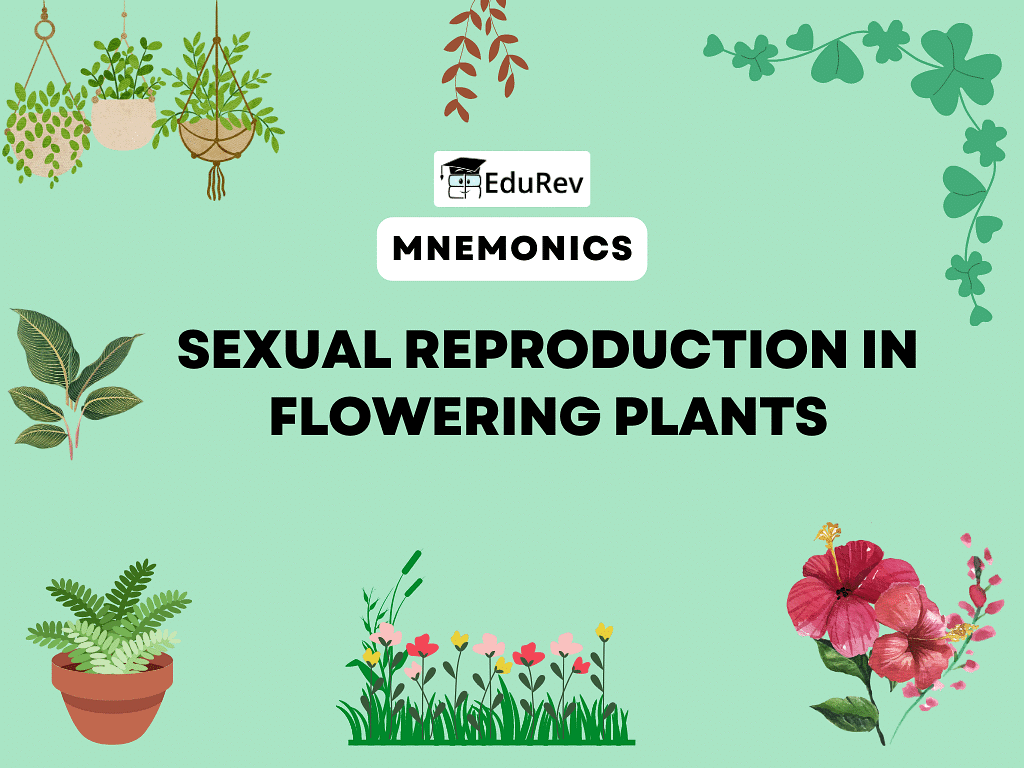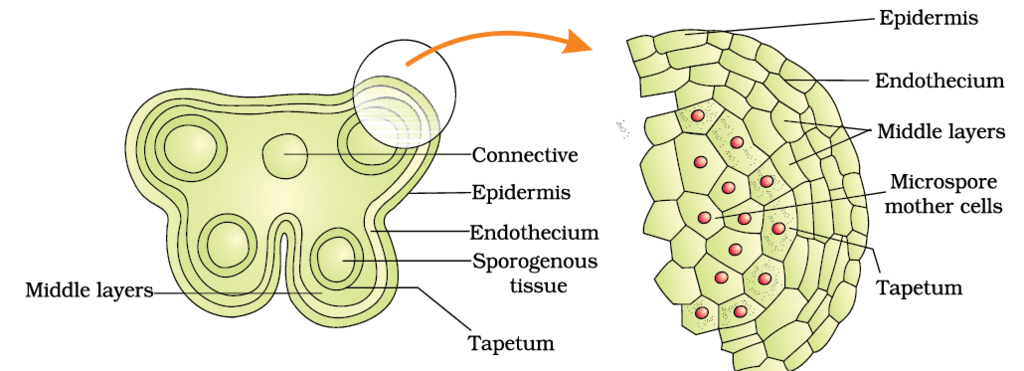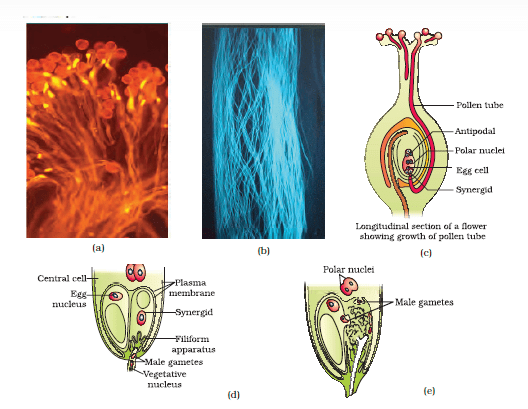Mnemonics: Sexual Reproduction in Flowering Plants | Biology Class 12 - NEET PDF Download
This document will help you remember important information about Sexual Reproduction in Flowering Plants in a fun and easy way. Inside, you'll find mnemonics—memory tricks—that will make it easier for you to remember key concepts, examples related to Sexual Reproduction in Flowering Plants.

Whether you're studying for an exam, preparing for a quiz, or simply looking to enhance your understanding of Sexual Reproduction in Flowering Plants, these mnemonics will serve as valuable memory tools. Utilize them alongside your regular study routine to reinforce your knowledge and increase your recall ability.
Happy mnemonic learning!
1. Structure of Microsporangium ( wall layers)
Mnemonic: "Every Man Taps Dancing"
Mnemonic Explanation:
- Every: Epidermis
- Man: Middle layers
- Taps: Tapetum
- Dancing: Endothecium

2. Structure of anatropus ovule
Mnemonic: "Fun Happy Children Made New Ice Embryo"
Mnemonic Explanation:
- Fun: Funicle
- Happy: Hilum
- Children: Chalaza
- Made: Micropyle
- New: Nucellus
- Ice: Integuments
- Embryo: Embryo
The ovule is a small structure attached to the placenta by means of a stalk called funicle.
The body of the ovule fuses with funicle in the region called hilum. Thus, hilum represents the junction between ovule and funicle.
Each ovule has one or two protective envelopes called integuments.
Integuments encircle the nucellus except at the tip where a small opening called the micropyle is organised.
Opposite the micropylar end, is the chalaza, representing the basal part of the ovule.
Enclosed within the integuments is a mass of cells called the nucellus.
Cells of the nucellus have abundant reserve food materials.
Located in the nucellus is the embryo sac or female gametophyte.
An ovule generally has a single embryo sac formed from a megaspore.

3. Types of Self Pollination
Mnemonic: "Auto Cats Can Go Xtra "
Mnemonic Explanation:
- Auto: Autogamy (Self-pollination within same flower)
- Cats: Chasmogamous (flowers open, but still self-pollinate)
- Can: Cleistogamous (flowers closed, always self-pollinate)
- Go: Geitonogamy (pollen from one flower to another on same plant)
- Xtra: Xenogamy (Cross-pollination between different plants)
Pollination in flowering plants can be classified into three types based on the source of pollen:
Autogamy: Pollination occurs within the same flower. This can include flowers that self-pollinate due to close proximity of anthers and stigma, such as in chasmogamous and cleistogamous flowers, the latter of which do not open and are always autogamous.
Geitonogamy: Pollen is transferred to a different flower but on the same plant. Functionally similar to cross-pollination, it is genetically equivalent to self-pollination since the pollen comes from the same genetic source.
Xenogamy: Pollen is transferred from the anther of one plant to the stigma of a different plant, ensuring genetic diversity by combining different pollen types. This is the only type that introduces genetically different pollen to the stigma.
4. Steps of Artifical Hybridisation
Mnemonic:"Every Bag Puts Special Re-bagging"
Mnemonic Explanation:
- Every: Emasculation
- Bag: Bagging
- Puts: Pollen collection
- Special: Stigma pollination
- Re-bagging: Re-bagging
Artificial hybridization is a crucial technique in crop improvement programs, focusing on controlled pollination to ensure genetic quality. The process involves several key steps:
Emasculation: This involves the removal of anthers from bisexual flowers using forceps before the anthers release pollen. This step is essential to prevent self-pollination.
Bagging: After emasculation, flowers are covered with bags, usually made of butter paper, to protect the stigma from unwanted pollen and external contamination.
Pollination: Once the stigma of the bagged flower is receptive, pollen grains from the selected male parent are carefully applied to the stigma.
Rebagging: After pollination, the flowers are covered again to secure the pollination process and allow the fruit to develop without interference.
 |
Download the notes
Mnemonics: Sexual Reproduction in Flowering Plants
|
Download as PDF |
5. Steps of Pollen Pistil Interaction
Mnemonic: "Great People Grow Every Single Day"
Mnemonic Explanation:
- Great: Germination on stigma (pollen germinates on stigma)
- People: Pollen tube growth (grows through style)
- Grow: Guided through micropyle (tube directed to ovule)
- Every: Enters ovule (pollen tube enters the ovule)
- Single: Sperm release (sperm enters egg and central cell)
- Day: Double fertilization (one sperm fertilizes egg, other fertilizes central cell)
 (a) Pollen grains germinating on the stigma; (b) Pollen tubes growing through the style; (c) L.S. of pistil showing path of pollen tube growth; (d) enlarged view of an egg apparatus showing entry of pollen tube into a synergid; (e) Discharge of male gametes into a synergid and the movements of the sperms, one into the egg and the other into the central cell
(a) Pollen grains germinating on the stigma; (b) Pollen tubes growing through the style; (c) L.S. of pistil showing path of pollen tube growth; (d) enlarged view of an egg apparatus showing entry of pollen tube into a synergid; (e) Discharge of male gametes into a synergid and the movements of the sperms, one into the egg and the other into the central cell
6. Outbreeding Devices
Mnemonic: "Separate Different Unisexual Plants Avoid Spatial Separation"
Mnemonic Explanation:
- Separate: Synchronous maturation (release of pollen and stigma receptivity at different times)
- Different: Dioecy (male and female flowers on separate plants)
- Unisexual Plants: Unisexual flowers (male and female flowers on different or same plant but prevent self-pollination)
- Avoid: Self-incompatibility (prevents self-pollination)
- Spatial Separation: Spatial separation (anthers and stigma in different positions)
|
49 videos|271 docs|174 tests
|
FAQs on Mnemonics: Sexual Reproduction in Flowering Plants - Biology Class 12 - NEET
| 1. What are the wall layers of a microsporangium? |  |
| 2. What is the structure of an anatropous ovule? |  |
| 3. What are the different types of self-pollination? |  |
| 4. What are the steps involved in artificial hybridization? |  |
| 5. What are the steps of pollen-pistil interaction? |  |


















